The shape of the plate that was used to apply lettering to a bottle may
or may not provide
information on how to narrow the date on beer bottles.
Below are the different
shapes of lettering that are found on glass
bottles
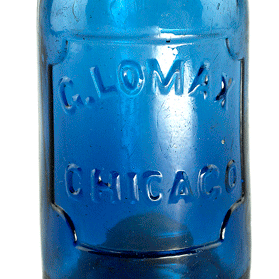 |
Cartouche Shaped Plate, Soda circ:
1855-1865
This
plate shape was rarely used and appears on bottles in the upper
Midwest only. Most of the bottles that used this plate
shape are from George Lomax of Chicago, Illinois, but there are
at least two other firms that used this plate style.
There
are two other bottles, one form New Orleans, Louisiana and a
second from Saint Louis, Missouri that had a cartouche shaped
design surrounding their embossing, but these are not plates and
were cut into the mold itself. |
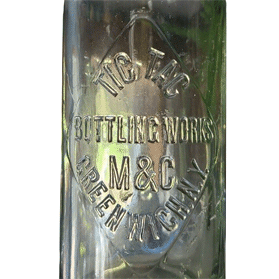 |
Diamond Shaped Plate, Soda circ:
1890-1900, Beer circ: 1885-1895
This plate shape was rarely used on Hutchinson bottles and has
only one use on a champagne beer bottle. Several of the
bottlers using bottles with this plate are clustered around or
from Corning, New York.
|

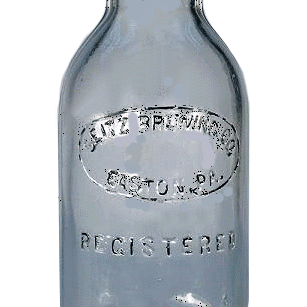
|
Ellipse Shaped Plate, Beer circ:
1846-1850 and 1895-1918
This plate shape was only used on beer bottles. There are
two distinct periods when this shaped plate was used.
The
first date to the period 1846 to 1850 and were used on bottles
produced by a Philadelphia area manufacturer and the bottles
using this plate were from firms located in Eastern Pennsylvania
and one from Camden, New Jersey. The plate is on the lower
portion of the bottle.
The second were used mainly on export
beer bottles having fluted bases and are made mainly with flint
glass. These bottles were used to bottle lager beer in an
export style and were used by bottlers that follow the
Appalachian mountains. These plates are generally located
closer to the shoulder of the bottle. |
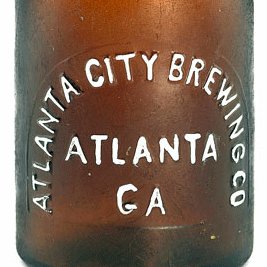
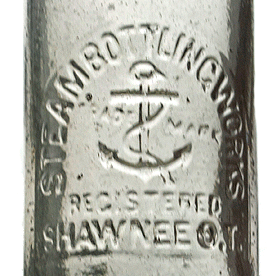 |
Horseshoe Shaped Plate, Soda circ:
1880-1915, Beer circ: 1875-1900
This plate shape was used extensively on soda, especially on
Hutchinson, bottles and on beer bottles to a much lesser
extent. The use on soda bottles also occurs on pony shaped
bottles and this plate shape was used mainly on East Coast
bottles. Many
of the Western bottles using this plate shape were manufactured by
East Coast glass works.
On beer bottles, plates with this
shape were used on some early porter bottles from the 1875-1885
period and later Weiss and lager beer bottles. Some of the
beer bottles have plates that fit into the front leaf and extend
from the shoulder to the base. The use on beer bottles was
less than six percent of that used on soda bottles. |
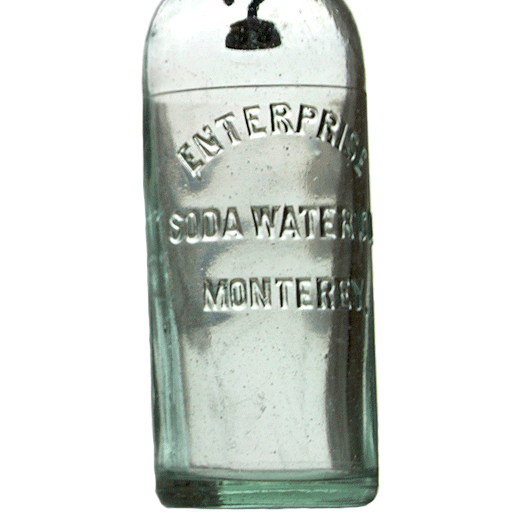 |
Leaf Plate, Soda circ:
1890-1920+, Beer circ: 1875-1920+
This
plate shape makes up one of the parts of four part molded
bottles and was used almost exclusively by glass works on the
West Coast, Canada, and England.
One beer bottles, there is
one early mold that was used by Cunningham & Ihmsen before they
went out of business in 1878. Their usage on beer bottles
picked up during the 1890s. |
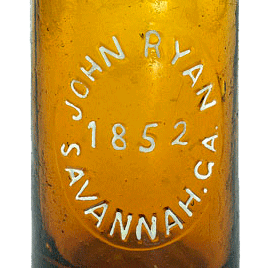 |
Oval Shaped Plate, Soda circ:
1880-1920+, Beer circ: 1878-1920+
The oval shaped plate was used extensively on soda and beer
bottles and was used extensively on East Cost bottles. |
 |
Rectangular Shaped Plate, Soda circ:
1848-1900, Beer circ: 1848-1910
The Rectangular shaped plate was the most popular shape of plate
used during the period 1850-1880, but continued to be used
occasionally in molds until about 1910. This form was
first used about 1848 by the Union Glass Works of Philadelphia
and was quickly adopted by other manufacturers. This plate
style was replaced by the oval and round plates during the 1870s.
Some times the plate fits into the front leaf of the mold and at
other times, it becomes part of the front leaf. These can be identified as the top and bottom lines of the plate
extend from seam to seam. |
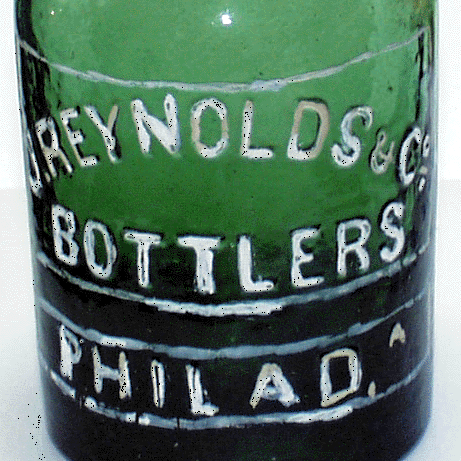 |
Double Rectangular Shaped
Plates, Beer circ: 1848-1852
The double rectangular plate had two plates that inserted into
the front leaf of the mold. It was initially introduced
about 1848 with the idea that the bottom plate could be used for
the city name and would not require the expense of engraving the
city for a new customer. This style of plating was used on
both a porter shaped bottle mold and an early ale shaped bottle.
The majority of these bottles are from Philadelphia and were
made by an area glass manufacturer. As such, these molds
have bottom plates engraved "Philada" or blank plates.
There are no known plates with other town names, even though
there is at least one bottles using this mold from a town
outside of Philadelphia. This bottle and those with no
embossing bear blank plates. |
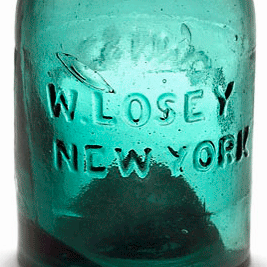
 |
Rectangular Shaped Front &
Back Plates, Soda circ:
1852-1857, Beer circ: 1852-1857
This approach of having a plates on the front and back of the
bottle was along the same lines as the replaceable city plate of
the double rectangular form. In this case the back plate
was used for a product, a plate for the manufacturer, or some
other decoration. "Brown Stout" in an arch was the most
common embossing of the reverse plate.
Union Glass Works, of
Philadelphia, was the manufacture of these bottles, which exist
in the porter, soda, and pony shaped bottles. Union Glass
Works is embossed on the reverse side plate of several soda
water bottles and around the base of one of the pony bottles.
The use of this mold ceased with the closure of this factory in
1857. |

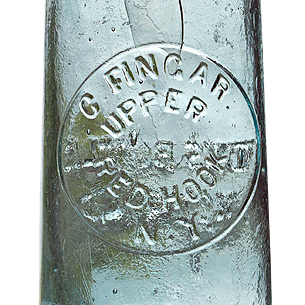 |
Round Shaped Plate, Soda circ:
1852-1857 and 1870-1920+, Beer circ: 1877-1920+
The round shaped plate was used extensively on soda and beer
bottles and was dominant in all markets.
An early iteration
was used on soda bottles in New Orleans, Louisiana and would
have been of Pittsburgh or a glass works of Midwestern origin.
These bottles date to the early 1850s. The form was
generally abandoned until used by the Hamilton glass works in
Ontario, Canada about 1870.
Their use on beer
bottles, started about 1877 on the early generation of bottles
to be used in bottling lager beer and some porter bottles.
This is by far the most common type of plate mold shape. |
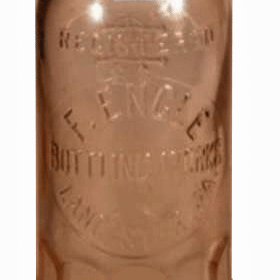
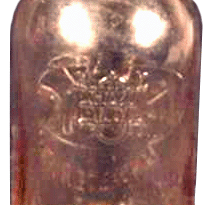 |
Round And Ellipse Shaped Plates, Beer circ:
1900-1910
This style of plates, with a round plate n the front and a
ellipse shaped plate on the reverse was only used by one
Lancaster, Pennsylvania bottler on two differently embossed
export beer bottles. The idea was that the name and city could
be embossed in the round plate on the front and the monogram of
the firm on the reverse. |
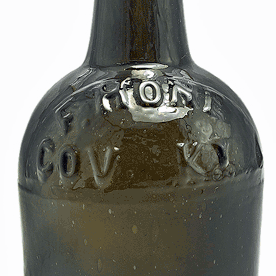 |
Semicircle Shaped
Plates, Beer circ: 1855-1865
The Semicircle plate was used exclusively on three mold porter
bottles of Ohio Valley manufacture. The plate is on the
shoulder of these bottles. At least two bottles are marked
" A. ARBOGAST" and "PITTS" on the base. This is also been
called the half-moon plate. |

